Couscous, those tiny, delightful granules of semolina, holds a place of honor far beyond a mere side dish. Its story is woven into the very fabric of North African and Mediterranean cultures, a testament to culinary ingenuity and enduring tradition. Tracing its origins back centuries, some historians believe couscous emerged from the Berber communities of ancient North Africa, developing as a staple grain that could sustain populations across diverse landscapes. Its unique preparation—steaming rather than boiling—transformed humble durum wheat into a light, fluffy, and highly versatile food, perfect for absorbing the rich flavors of stews and sauces.
As empires rose and fell, and trade routes flourished, couscous embarked on its own journey of expansion. From its North African heartland, it traveled across the Sahara, reaching West African nations, and sailed across the Mediterranean to Sicily, parts of Spain, and eventually France, where it has become a widely embraced dish. Each region adopted couscous into its own culinary lexicon, infusing it with local ingredients and distinct preparation methods, creating a tapestry of couscous variations that speak to its adaptability and universal appeal.
More than just food, couscous is a symbol of community and celebration. In many cultures, especially in Algeria, it’s the centerpiece of family gatherings, religious holidays, and special occasions. The act of preparing couscous, often a communal endeavor, brings people together, sharing stories and laughter as the semolina is meticulously rolled, steamed, and fluffed. It’s a dish that embodies hospitality, often served in generous portions to welcome guests and ensure everyone is well-fed and content.
Today, couscous continues to evolve, finding new expressions in contemporary cuisine while remaining deeply rooted in its heritage. Whether it’s the hearty, vegetable-laden Algerian style, the spicier Moroccan tagines, or lighter, more modern interpretations, couscous remains a beloved and iconic dish. It’s a culinary bridge connecting generations and cultures, a humble grain with an extraordinary past, and a bright future on dinner tables around the world.
Algerian Couscous with Seven Vegetables (Couscous aux Sept Légumes)
This classic Algerian couscous is a hearty and flavorful dish, often served for special occasions and family gatherings. The slow-cooked stew (marka) is rich with tender meat and a medley of vegetables, perfectly complemented by light and fluffy couscous.
Yields: 6-8 servings Prep time: 45 minutes Cook time: 2-3 hours
Ingredients:
For the Couscous:
- 500g (approx. 2.5 cups) medium grain couscous
- 2 tablespoons olive oil
- 1 teaspoon salt
- 1 cup warm water (for first steaming)
- 1.5 cups warm water (for second steaming)
- 1 tablespoon butter or smen (clarified butter) for finishing
For the Stew (Marka):
- 1 kg (2.2 lbs) lamb or beef (on the bone preferred, cut into large pieces)
- 4 tablespoons olive oil
- 2 large onions, finely chopped
- 4-5 cloves garlic, minced
- 2 large ripe tomatoes, grated or finely chopped
- 2 tablespoons tomato paste
- 1 teaspoon ground ginger
- 1 teaspoon turmeric
- 1 teaspoon sweet paprika
- 1/2 teaspoon black pepper
- 1/4 teaspoon saffron threads (optional, soaked in a little warm water)
- Salt to taste
- 2 liters (approx. 8 cups) hot water
- Vegetables (the “seven” can vary, here’s a common selection):
- 3-4 carrots, peeled and cut into large chunks
- 2-3 zucchinis, trimmed and cut into large chunks
- 1 small white cabbage, cut into quarters
- 2-3 turnips, peeled and halved or quartered
- 1 cup chickpeas, soaked overnight and cooked, or canned (rinsed)
- 1 cup pumpkin or butternut squash, peeled and cut into large chunks
- 1-2 potatoes, peeled and quartered (optional, added later)
- A handful of fresh parsley and cilantro, tied into a bouquet garni
Equipment:
- Couscoussier (a special two-tiered steamer) is ideal, but a large pot with a steamer basket will work.
Instructions:
Step 1: Preparing the Couscous Grains In a large bowl, add the couscous grains. Drizzle with 2 tablespoons of olive oil and a pinch of salt. Using your fingertips, gently rub the oil into the grains until each grain is lightly coated and separated. This prevents clumping.
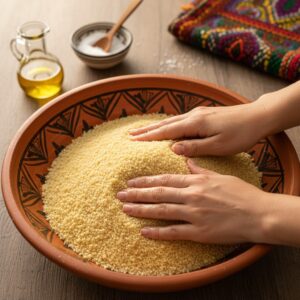
Step 2: Starting the Stew (Marka) In the bottom part of your couscoussier (or a large heavy-bottomed pot), heat the 4 tablespoons of olive oil over medium heat. Add the chopped onions and cook until softened and translucent, about 5-7 minutes. Add the meat and brown it on all sides.
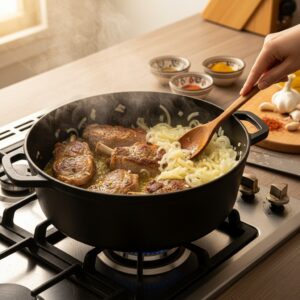
Step 3: Adding Spices and Liquids to the Stew Stir in the minced garlic, grated tomatoes, and tomato paste. Add all the dry spices: ginger, turmeric, paprika, black pepper, and salt. If using saffron, add it now. Sauté for another 5 minutes, allowing the flavors to meld. Pour in the hot water, ensuring the meat is mostly covered. Bring to a boil, then reduce heat to a simmer. Add the bouquet garni of parsley and cilantro.
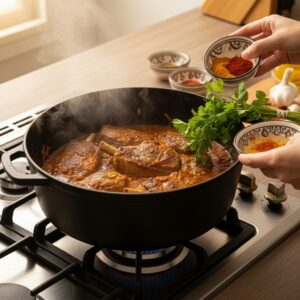
Step 4: First Steaming of Couscous Place the seasoned couscous grains into the top part of the couscoussier (the steamer basket). Ensure the holes are not blocked. Place the top part securely over the simmering stew. The steam from the stew will cook the couscous. Steam for about 20-25 minutes, or until steam visibly rises through the couscous.
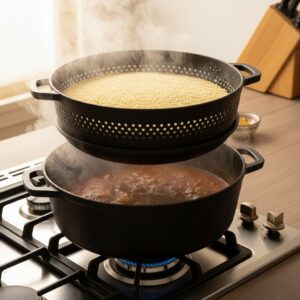
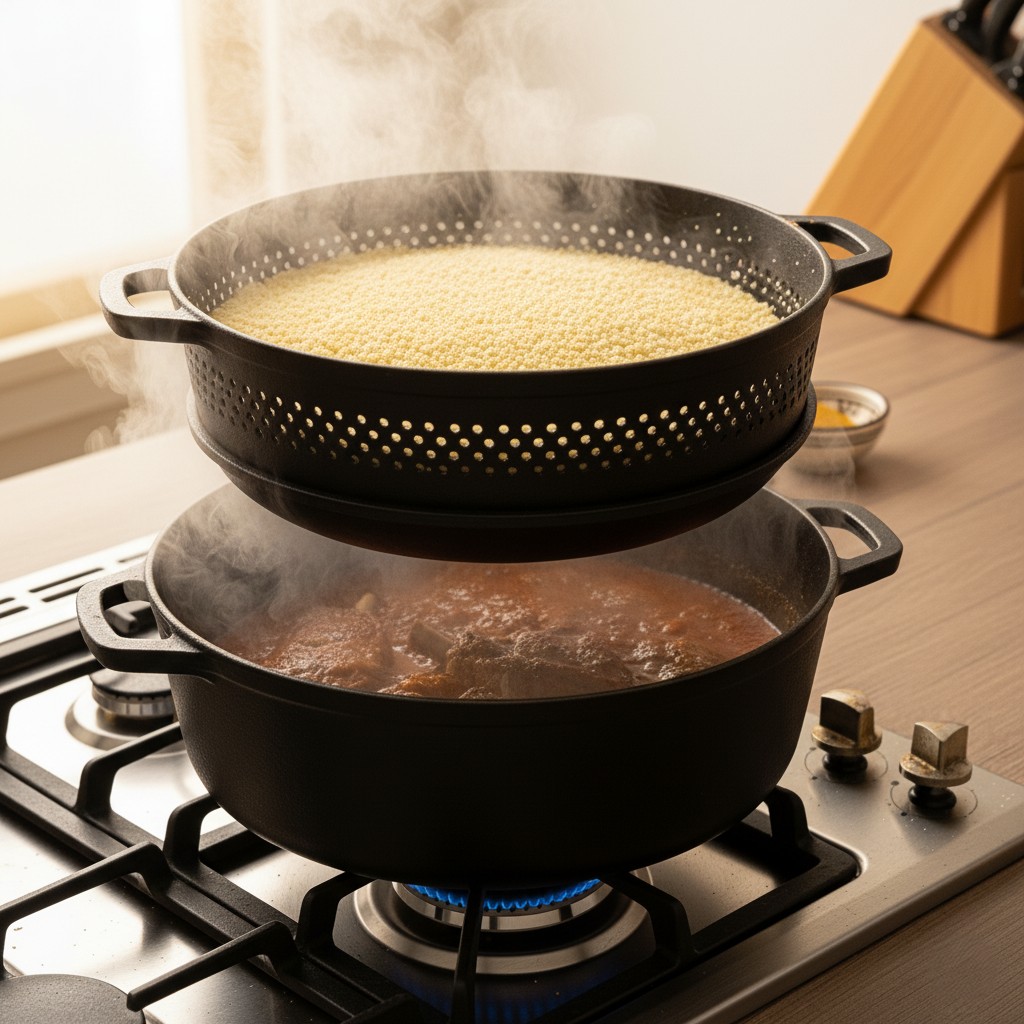
Leave a Reply
You must be logged in to post a comment.